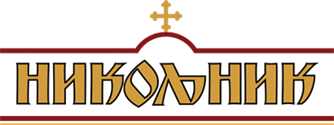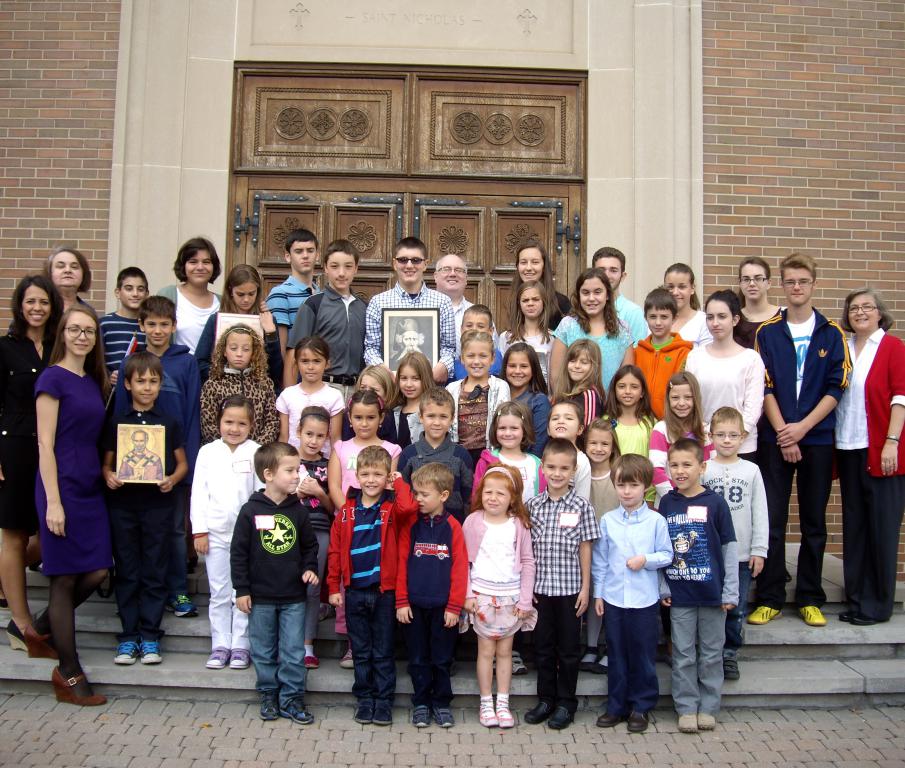60 Years of our Serbian School
Regardless of their specific ethnic identity, all diasporas have something in common. That is a nostalgic respect for the past, often with a sense of sweet yearning, and a regard for the future which is at once both hopeful and trepidant. That trepidation stems from a collective worry that the tried and true values of their old homeland might one day be lost. If misfortunes led nations into diaspora, the people of that diaspora managed to salvage its most precious gems and bring them to their new homeland; these are their language, faith and customs. In a new setting the members of a diaspora strive to preserve these treasures, not as relics of the past but in a firm belief that their value will only increase with time. These three pearls are the foundation of an identity by which their descendants will be known among other nations. Members of a diaspora live in the hope that their children will value this threefold inheritance, and understand how much knowledge, wisdom, beauty and spiritual fulfilment they can achieve through it..
Through a turbulent history, the Serbs have created diaspora communities throughout Europe, and in modern times on every inhabited continent. Some quickly faded through assimilation, such as the colonies of New Serbia in czarist Russia, on the territories of today’s Ukraine and southern Russia. Others had their heyday, but proudly remaining standing, like the Serbian communities of Timisoara in Romania, and Szentendre and Budapest in Hungary. Others still flourish today, not only in number but in efforts to preserve their cultural heritage; this is certainly the case with the Serbian community of Trieste, Italy, gathered around the 19th century church of St. Spiridon, whose blue domes are a landmark in this northern Adriatic city.
Our own diaspora has deeper roots than many of us realize. The first record of Serbs living in Hamilton dates back to 1904. This small community created our parish in 1913, and built its first church in 1917. From its beginnings, the Serbian community of Hamilton has been oriented to its church. The colony grew slowly, and with time, a notable number of Canadian-born Serbian children created a need for a school. The first school for children of Serbian heritage in Ontario was our own parish Serbian School, founded in 1948.
Two parishioners, Dobrosav Ilić and Lazar Đ. Stojšić, first organized lessons for the singing of liturgical responses. These men belonged to the post-war generation of Serbian immigrants who left their homeland reluctantly, and vowed to struggle for the existence of the Serbian people. Mr. Ilić, known as Čika Žaca because he was a gendarme in Pirot, and Mr. Stojšić, or Čika Laza, a journalist from Srem, also became founding members of the “Stevan Mokranjac” Choir and “Jovan Sterija Popović” Theatre group. Also, Čika Laza was life-long editor of Hamilton-based “Canadian Srbobran” newspaper and cantor in our parish church. Together, they began a small school which soon expanded to include Serbian language & history lessons. With the arrival of our long-time parish priest, V. Rev. Djuro Vukelić, religious instruction was strengthened even further.
From 1957, the school had a qualified teacher, Bogdana Stošić (nee Dukić), who came to Canada from her beloved city of Knin, in Dalmatia. Educated in Split, with teaching experience in villages of Northern Dalmatia (Matasi, Golubić), Bogdana’s experience and training began creating in our parish school an atmosphere that only a true pedagogue could foster. Her efforts led to a marked increase in school enrolment. A great admirer of Serbian dramatic arts and musical culture, she taught her pupils songs and short plays, alongside lessons in language and religion. She exposed many of the children for the first time to works of Serbian literature and our nation’s epic poetry. During her time with the school, the Saint Sava Day celebrations of our parish took on a truly festive air, and became a noteworthy date in the community’s cultural calendar. She also had the great honour to greet, with her pupils, HRH King Petar II Karađorđević when he visited Hamilton’s Serbian community in 1957. In 2014, it was a poignant moment as her son, Aleksandar Stošić, was able to greet King Petar’s son, HRH Crown Prince Aleksandar Karađorđević. With students and all of the teachers, the Prince was presented with a photo of the 1957 visit, one that he had never before seen.
Despite the unfortunate events of the church schism in 1963, the school continued its mission, uninterrupted. At times when the school was left without a teacher, Rev. Djuro Vukelić would step in to teach; fortunately, these periods were brief and rare. Our school can proudly say that it has been able to function continuously since its inception. To our present day, the school has had an additional 30 teachers. They are: Radoslava Cica Vukelić, Bosa Lemajić, Marija Menićanin, Bosa Rezničak, Ankica Marković, Vera Marković, Jovan Lapadić, Dragan Metikoš, Đorđe Lukić, Draginja Trkulja, Nada (Zarić) Pavlović, Marina (Šoškić) Teofilović, Kata (Njegovanović) Timotijević, Julka Gaćeša, Javorka Prtenjak, Vesna Stanojević, Ljubiša Vlatković, Ana (Marijan) Dangubić, Bojana (Sarić) Milojević, Đurđa (Navala) Daić, Zorica (Milaković) Marić, Slavko Zubac, Zorka Đurđević, Duško Delić, Snežana Ševo Žmukić, Jelena Aleksandrov, Katarina (Milenković) Pavić, and the current team of Milka (Mitrović) Lukić, Danijela Jović, Milena (Krljar) Trojanović, and Aleksandar Stošić.
An even longer list of names could be written if we were to mention the many people who have helped our school, from volunteers to dedicated parents, not to mention the unwavering support of our parish Board and the Kolo Srpskih Sestara (Circle of Serbian Sisters). Although we can’t mention everyone, we know that they all helped selflessly because they believed in our school’s one goal: that our students should know who they are!
Over the decades, our school has grown and progressed. Since 1990, we have been fortunate to have a permanent home in proper school facilities, housed below our church. A library has been formed, and many lessons and curriculum packages have been created. Our pupils were honoured to greet His Holiness Serbian Patriarch Pavle on the occasion of his visit to the Serbs of Canada and the USA in 1991. With the arrival of current parish priest, V. Rev. Vojislav Pavlović, our sense of support and encouragement in our goals has only increased. We now regularly receive teaching materials from Serbia, alongside those published in North America; this would’ve been unthinkable at the time of the school’s inception. Most of our material, though, remains self-generated, as in the beginning. Luckily, our current team consists of five fully qualified teachers, which we hope is reflected not only in the quality of instruction, but also in our results. In the parish’s Centennial year, the school acquired modern instructional technologies, thanks to our benefactors, Krunoslav & Theresa Perković. A full range of instructional strategies is now available to our teachers and pupils. Close cooperation between our Parish Bookstore, organized by Jovan Djurdevic, and Potamitis Publishing in Greece has enabled our students to have access to beautiful materials for learning about their faith. Similarly, both Serbia’s Ministry of the Diaspora and the Kreativni Centar publishing house have provided us with books and other materials for Serbian language and culture, and Orthodox catechism.
How, then, do we, the teachers of the diaspora, look on the future of our school and community? How do we experience that combination of hope and trepidation that marks the pscyhe of a diaspora? It is difficult to say… of course we hope for the best, but we do worry about the neglect shown for Serbian culture, not so much among our own very committed families and pupils, but among those who still remain outside of our circle of learning in church and in school. We hope that our pupils will preserve their language and faith, and nurture a love for the history and traditions of their people.But we hope even more that they will strengthen and spread the treasure that they have, as ambassadors or Serbian culture in the Canadian mosaic, and one day as parents of a new generation of Canadian Serbs. We also hope that those Serbian families who until now, for whatever reason, have not seen the value of this cultural inheritance, finally realize the wealth that we collectively have and join us in our task of preserving our heritage. Our school and our parish have survived many challenges and changes, and we believe it will survive many more. So long as the school has teachers, parents, and pupils who work for the benefit of the faith and nation of St. Sava, the ominous words of Jovan Jovanović Zmaj’s poem, «Dižimo Škole» should not become reality: «Jer biće dana, al neće sreće, i biće ljudi al Srba neće» «For there shall be many days ahead, but not always good fortune; and there will be many people to come, but not Serbs among them».
60 years of continuous work – few organizations in the diaspora can be proud of such an achievement. Six decades of effort dedicated to the propagation of Orthodoxy and Serbian identity… truly we have been blessed by God to be worthy of such an honourable struggle. Working for the preservation of our culture in our community is only a small contribution to the wider effort of many parishes and organizations across Canada. Let’s add to this effort, each and every one of us, by our own efforts at home, in our families, and in our church. Let’s never forget our threefold treasure – language, faith, and customs – and let’s make an effort to preserve them for future generations of our Canadian diaspora. Our people have the saying that «Svako se dobro tek pozna kada se izgubi» …” You only recognize a good thing when you’ve lost it”. Don’t let our descendants learn such a bitter lesson – let them never know the awful feeling of having lost one’s name and soul.
A. Stošić


